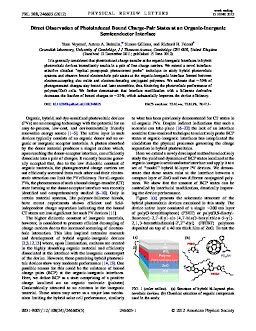2012-06-15
Direct observation of photoinduced charge-transfer states at organic-inorganic interface
Publication
Publication
Phys. Rev. Lett. , Volume 108 - Issue 24, Article number: 246605 p. 1- 5
It is generally considered that photoinduced charge transfer at the organic-inorganic interfaces in hybrid photovoltaic devices immediately results in a pair of free charge carriers. We extend a novel interface-selective ultrafast “optical pump-push photocurrent probe” technique to study hybrid photovoltaic systems and observe bound electron-hole pair states at the organic-inorganic interface formed between electron-accepting zinc oxide and electron-donating conjugated polymers. We estimate that ∼50% of photogenerated charges stay bound and later recombine, thus hindering the photovoltaic performance of polymer/ZnO cells. We further demonstrate that interface modification with a fullerene derivative decreases the fraction of bound charges to ∼25%, which substantially improves the device efficiency.
| Additional Metadata | |
|---|---|
| American Physical Society (APS) | |
| doi.org/10.1103/PhysRevLett.108.246605 | |
| Phys. Rev. Lett. | |
| Organisation | Ultrafast Spectroscopy |
|
Vaynzof, Y., Bakulin, A., Gélinas, S., & Friend, R. (2012). Direct observation of photoinduced charge-transfer states at organic-inorganic interface. Phys. Rev. Lett., 108(24, Article number: 246605), 1–5. doi:10.1103/PhysRevLett.108.246605 |
|
